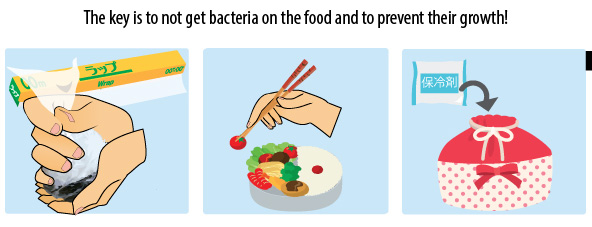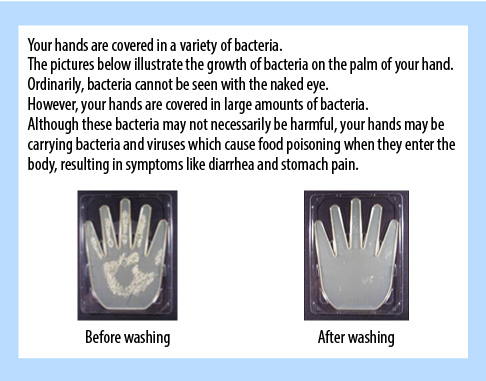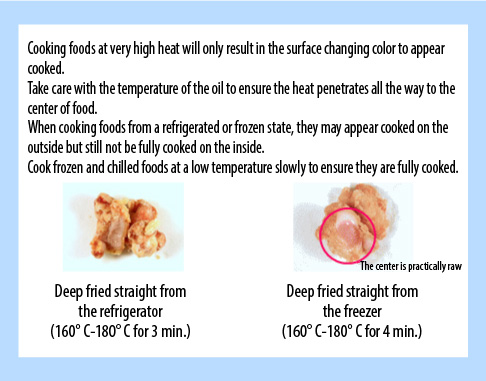Tokyo Food Safety Information Center » Tokyo Metropolitan Government food safety FAQ » What should I be careful about when making box lunches?
What should I be careful about when making box lunches?

What should I be careful about when making box lunches?
- Are there any dishes which shouldn’t be served in a box lunch?
- Are there any things I should be careful about when making sandwiches and other foods with bread for a box lunch?
- Can I use homemade frozen dishes in place of an ice pack similar to commercially sold frozen foods?

As box lunches are not eaten immediately after they are made, bacteria can grow in them before they are eaten and cause food poisoning. The key is to avoid letting bacteria get in the foods in the box lunch and then to prevent bacteria from multiplying after the lunch is prepared.
Accordingly, be sure to thoroughly wash your hands before preparing box lunches. In addition, heat cooked foods thoroughly so the heat reaches their center, then cool them thoroughly before placing them in the lunch box with chopsticks or another utensil. As dishes with a high moisture content can promote bacterial growth, use foods that are difficult for bacteria to grow on like deep fried, sautéed, and heavily seasoned foods. It is also important to store box lunches at low temperature after they are prepared.


Do not allow bacteria to get on the food
・Thoroughly wash hands when preparing the food.
・Use clean chopsticks or another utensil to place the food in the lunch box.
・When making rice balls, as much as possible use plastic wrap to hold and mold them to prevent bacteria on your hands from getting in the balls.

Destroy bacteria
Thoroughly cook food to its center to kill any bacteria. Foods like fried eggs, Hamburg steaks, and deep fried foods can be difficult to cook all the way to the center; be sure to take extra care to thoroughly cook these foods.

Prevent bacteria from growing
1. Key points in choosing food
•Bacteria grow more easily when there is a lot of water. Accordingly, cook foods that are low in water content such as sautéed or deep fried foods.
•Season foods strongly and with lots of salt or sugar to prevent bacteria growth.
•Dishes like chopped fish salads which are cut or stirred can easily be contaminated with bacteria and bacteria grow in them easily. Store these dishes at low temperature.
•Dishes best not served in a box lunch:
•Uncooked foods like sashimi
•Insufficiently cooked foods like soft boiled eggs
•Foods which need to be packed long after they are prepared, such as dishes made the night before
2. Key points for storage
Bacteria grow most easily between 10° C and 60° C. As much as possible, store box lunches and the food inside at temperatures outside this range.
•Close the box lunch lid after rice and other dishes have fully cooled.
•Use cold packs when necessary to keep the temperature low and prevent bacteria growth. Although rice may become somewhat hard if cooled too much, it will return back to normal if heated in a microwave.
•When using a highly insulated lunch box for hot foods, try to place hot foods in the box as soon as possible after cooking and keep them at least 65° C.
In order to prevent food poisoning caused by your box lunches, it is important to keep the time between when the lunch is made and eaten as short as possible. Eat box lunches as soon as possible.
Box lunches containing sandwiches and other foods which include bread are handled basically the same way as rice-based lunches, but the following points require particular attention.
•Thoroughly wash your hands and if possible use disposable gloves when handling bread and ingredients.
•Thoroughly wash raw vegetables and fruit with water to get rid of any bacteria on them.
•Thoroughly cook any cooked ingredients so that the heat penetrates all the way to their center and kills any bacteria. Avoid using partially cooked, runny eggs.